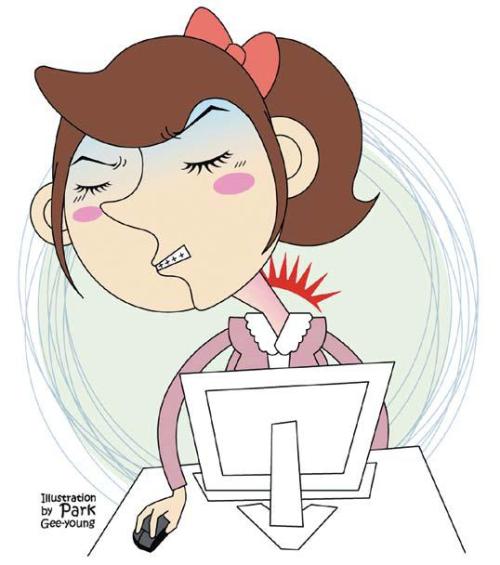Not commonly found in manual laborers, the forward head posture may occur in individuals who stay in the same posture for long periods of time while working.
If muscle contraction and relaxation are repeated, this may prevent the occurrence of the condition. In individuals who maintain the same posture for extended periods of time, however, it may occur because of persistent muscle tension.
Occupational groups at increased risk of developing forward head posture are draft designers, designers and computer workers. That is, it commonly occurs in individuals who frequently stare in a single direction while in a prolonged sitting position.

Among computer workers, those who simply type will deal with symptoms of forward head posture to a lesser extent, but those who frequently operate a computer mouse will encounter them far more frequently.
These individuals complain of not only pain in the neck, but also muscle pain in areas such as the wrist and thumb. This is not only because a great burden is exerted on one side but also because the same posture is maintained for a prolonged period of time when they operate a computer mouse.
Symptoms
The muscles associated with the neck are interconnected in the areas ranging from the occiput to the upper region of the shoulder. Accordingly, this makes individuals perceive the pain even in areas such as the neck, occiput and shoulder.
The neck normally forms a natural curve in an X-ray. In the above occupational groups, however, it often has a linear shape. That is, a line is created because muscle tension pulls the bone. This makes individuals more susceptible to herniation of the cervical disc due to a loss of the flexibility of the cervical spine if there is a sudden impact such as that experienced in car accidents.
The principles of joint protection
In a sitting position with the neck extended, i.e., the “turtle neck position,” a great burden is exerted to the muscles in the posterior neck.
The occurrence of the symptoms cannot be prevented through maintaining good posture.
From the perspectives of both prevention and treatment of forward head posture, however, it is essential to apply body mechanics as well as the appropriate posture to daily activities or working. This may lessen the stress exerted on the muscles and joints around the neck and shoulders. Also, an arm sling may be a highly effective tool when it is used to lessen the stress to both arms in the occupational groups that frequently operate a computer.
Treatment
When individuals visit hospitals with the chief complaint of severe pain, they are recommended to undergo physical therapy and injection therapy for myofascial pain. It is essential, however, to do muscle strength exercises as well as to stretch the muscles around the neck and shoulder, not to mention maintain an appropriate working posture.
If muscle contraction and relaxation are repeated, this may prevent the occurrence of the condition. In individuals who maintain the same posture for extended periods of time, however, it may occur because of persistent muscle tension.
Occupational groups at increased risk of developing forward head posture are draft designers, designers and computer workers. That is, it commonly occurs in individuals who frequently stare in a single direction while in a prolonged sitting position.

Among computer workers, those who simply type will deal with symptoms of forward head posture to a lesser extent, but those who frequently operate a computer mouse will encounter them far more frequently.
These individuals complain of not only pain in the neck, but also muscle pain in areas such as the wrist and thumb. This is not only because a great burden is exerted on one side but also because the same posture is maintained for a prolonged period of time when they operate a computer mouse.
Symptoms
The muscles associated with the neck are interconnected in the areas ranging from the occiput to the upper region of the shoulder. Accordingly, this makes individuals perceive the pain even in areas such as the neck, occiput and shoulder.
The neck normally forms a natural curve in an X-ray. In the above occupational groups, however, it often has a linear shape. That is, a line is created because muscle tension pulls the bone. This makes individuals more susceptible to herniation of the cervical disc due to a loss of the flexibility of the cervical spine if there is a sudden impact such as that experienced in car accidents.
The principles of joint protection
In a sitting position with the neck extended, i.e., the “turtle neck position,” a great burden is exerted to the muscles in the posterior neck.
The occurrence of the symptoms cannot be prevented through maintaining good posture.
From the perspectives of both prevention and treatment of forward head posture, however, it is essential to apply body mechanics as well as the appropriate posture to daily activities or working. This may lessen the stress exerted on the muscles and joints around the neck and shoulders. Also, an arm sling may be a highly effective tool when it is used to lessen the stress to both arms in the occupational groups that frequently operate a computer.
Treatment
When individuals visit hospitals with the chief complaint of severe pain, they are recommended to undergo physical therapy and injection therapy for myofascial pain. It is essential, however, to do muscle strength exercises as well as to stretch the muscles around the neck and shoulder, not to mention maintain an appropriate working posture.

By Hwang Ji-hye, M.D. Ph.D.
The author is a professor at the Department of Rehabilitation Medicine of Sungkyunkwan University School of Medicine and a doctor at Samsung Medical Center.
-
Articles by Korea Herald




![[Herald Interview] 'Amid aging population, Korea to invite more young professionals from overseas'](http://res.heraldm.com/phpwas/restmb_idxmake.php?idx=644&simg=/content/image/2024/04/24/20240424050844_0.jpg&u=20240424200058)













![[KH Explains] Korean shipbuilding stocks rally: Real growth or bubble?](http://res.heraldm.com/phpwas/restmb_idxmake.php?idx=652&simg=/content/image/2024/04/25/20240425050656_0.jpg&u=)

